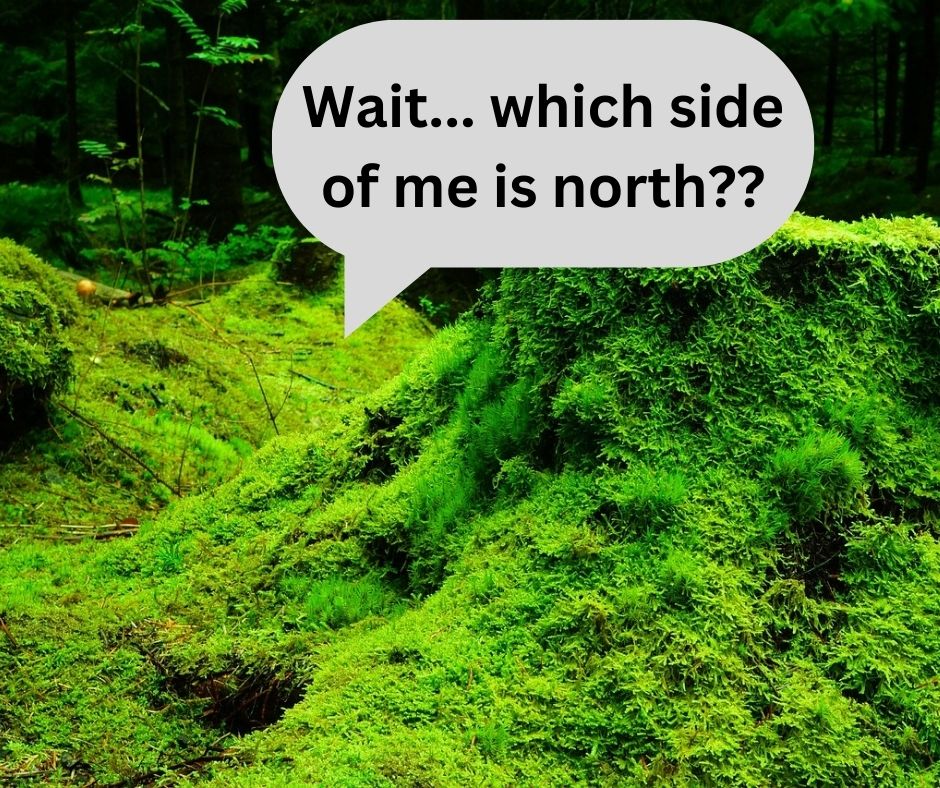While working on the third Roc Rider novel, I recently found myself in the position of trying to figure out how a blind person could determine which direction is north without asking a sighted person.
The short answer: they mostly can’t. At least, not very precisely.
The long answer? Well…
As it turns out, people have developed many cool methods over the years for figuring out which direction is north without a compass. The first thing that probably pops into your head is the old saw about moss only growing on the north side of trees.
As any Boy Scout worth his merit badges can tell you, though, the moss on the north side thing simply isn’t true. (Boy, would it ever be handy if it was for the composition of this scene, though!)
Moss grows where things are dampest. While in the northern hemisphere, there is a slightly higher chance of the north half of a tree being damp because it’s colder in that general direction, moss will grow anywhere there is moisture to feed it. See the picture below for Exhibit A.

Obviously, you can use the stars. But you can also figure it out by marking the progress of shadows across the ground to determine the east/west axis and reckoning it that way.
You can use an analog watch to figure it out, too, as it turns out. Point the hour hand at the sun, then find the point halfway between the hour hand and 12 (or the hour hand one if it’s Daylight Savings Time). That point is south, so it’s easy to figure out north from there. (Note that this only works this way in the northern hemisphere where I’m from. If you find yourself in the southern hemisphere, you can still use a watch, but the process is slightly different.)
The one thing all of these methods have in common, at least at first glance? You have to be able to see to use them.
So, since we can’t figure it out by feeling for moss on trees and all these other methods require sight, what does one do?
I’ve come up with three potential methods.
- Reckon it by the direction of the wind. Yes, the wind is air, and obviously, it can go wherever it wants. Still, in many places, you can reliably assume that the wind will be blowing in a particular direction most of the time. If you’re where I am, you can count on the wind mainly blowing west to east 80 – 90% of the time. If the wind is equally reliable where our character is, you could feel its prevailing direction and use it as your anchor to orient yourself. Provided the wind is blowing, of course.
- You could use a workaround on the shadow trick! How? By feeling the movement of a shadow across your skin. If a person could feel the cool spot of a shadow shift with the shifting sun, that could give them the east/west axis, similar to how visually marking the movement of shadows could. For this to work, the person would likely need something they could stick in the ground to purposefully create a shadow so they’d know that’s what it was. But still, it’s a possibility.
- Another workaround, this time on the watch trick! If the character had a watch (the character in my book’s case doesn’t, but still), they could remove the protective glass and use the watch trick by feeling for the hour hand, then orienting toward the sun by feeling the warmth on their face. Then, all you’d have to do is feel for the 12 point on the watch, and the process would be pretty straightforward from there.
It turns out figuring out north without being able to see isn’t as impossible as it first appears! Granted, none of these methods will give you a super precise bead on north, but it would likely be enough to get one going in generally the right way.
Which method is Able using to navigate in the third Roc Rider book? Well, that, dear readers, you’re simply going to have to read and discover for yourself once the book comes out.
Thanks for reading! Nab a free short story, “Of Gods and Vermin”, read sneak peeks of my works in progress, and more, by signing up for my newsletter

